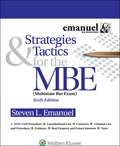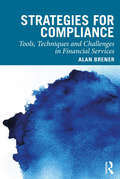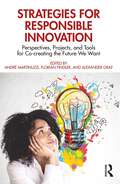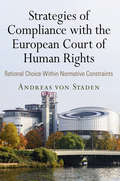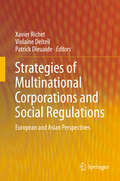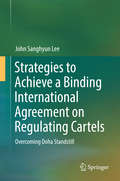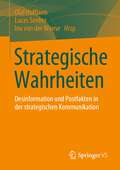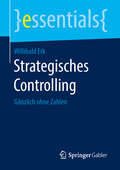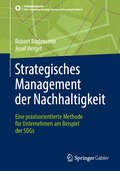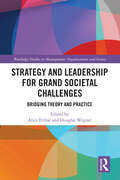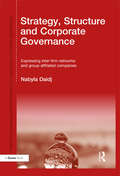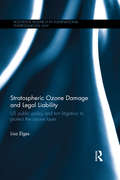- Table View
- List View
Strategies and Tactics for the MBE (Emanuel Bar Review)
by Steven EmanuelStrategies & Tactics for the MBE, 6E is full of up-to-date advice on how to analyze Multistate Bar Exam (MBE) questions, including details on how to handle each MBE subject, specific, step-by-step strategies for analyzing different question types, tips about how subtle differences in wording can completely change the meaning of an answer, and strategies for "rewording" questions in your mind to make them easier to analyze. Updated by Steven Emanuel, Strategies & Tactics for the MBE, 6E contains a full-length, 200-question practice MBE exam, as well as more than 325 additional questions broken down by subject a total of over 500 NCBE-released questions. The new edition also includes 70 author-generated Civil Procedure questions. Each subject begins with detailed advice on how to handle MBE questions on that subject and how to focus your studies on the most common and trickiest MBE topics. Every question has a fully explained answer that analyzes, in detail, every answer option. Features: Updated to include a comprehensive section on Civil Procedure, which was recently added to the MBE exam. This new section features approximately 70 author-generated questions. For the traditional MBE topics (Constitutional Law, Contracts, Criminal Law and Procedure, Evidence, Real Property and Future Interests, and Torts), every one of the more than 500 questions in this book represents an actual question asked on a past MBE. These questions have been reviewed for accuracy and updated.
Strategies for Compliance: Tools, Techniques and Challenges in Financial Services
by Alan BrenerCompliance is a fundamental control function within regulated industries globally. This book provides an expert introduction to corporate compliance using cases, examples and insights from the financial services sector and beyond. The author, an experienced compliance practitioner and academic, highlights compliance challenges, using examples such as Wells Fargo, whistleblowing in the financial services and the mis-selling of payment protection insurance in the UK banking sector. The book explores strategies for creating compliant cultures and fostering regulatory trust, whilst practical guidance is provided on anticipating regulatory changes. Addressing organisational obstruction and delay, the author presents a series of valuable tools and techniques for real-world practice. An essential professional development resource for board directors, compliance officers and other senior managers, the book also provides a unique learning and development resource for students of corporate compliance globally.
Strategies for High-Tech Firms: Marketing, Economic, and Legal Issues
by P.M. Rao Joseph A. KleinThis is the first book to present marketing strategy of high-tech products and services in a legal, economic, and global context. From software to hardware, from pharmaceuticals to digital movies and TV, the authors argue that the understanding of intellectual property rights (IPRs) is essential to devising effective marketing strategies.
Strategies for Responsible Innovation: Perspectives, Projects, and Tools for Co-creating the Future We Want
by André Martinuzzi Alexander Graf Florian FindlerHow can responsible business work in the highly competitive areas of innovation? Focusing on business opportunities and illustrating how Responsible Innovation can be successfully implemented in practice, this book captures experiences and insights from key decision‑makers in business, politics, and academia, to answer this question. In addition to interviews with leading thinkers in the field, Strategies for Responsible Innovation describes the experiences of eight EU projects and provides tools for Responsible Innovation in the business sector.The examples in this book illustrate how to move from a vague societal aspiration to a business case for Responsible Innovation, and provide a compelling argument for collaboration at the important intersection between government, business, and academia. In this way, Responsible Innovation transcends a singular market-based approach to deliver value at many levels, co-creating in a truly inclusive manner. The book sheds light on the strategic benefits of applying the concept of Responsible Innovation in practice and offers concrete tools for its implementation.Aimed primarily at managers of innovation processes in organizations, and consultants and facilitators working on Responsible Innovation and sustainability management, the book also provides insight into the logic and principles of Responsible Innovation management for academics, policy-makers, and civil society organizations, helping them better communicate their requirements to business.
Strategies of Compliance with the European Court of Human Rights: Rational Choice Within Normative Constraints (Pennsylvania Studies in Human Rights)
by Andreas Von StadenIn Strategies of Compliance with the European Court of Human Rights, Andreas von Staden looks at the nature of human rights challenges in two enduring liberal democracies—Germany and the United Kingdom. <P><P>Employing an ambitious data set that covers the compliance status of all European Court of Human Rights judgments rendered until 2015, von Staden presents a cross-national overview of compliance that illustrates a strong correlation between the quality of a country's democracy and the rate at which judgments have met compliance. Tracing the impact of violations in Germany and the United Kingdom specifically, he details how governments, legislators, and domestic judges responded to the court's demands for either financial compensation or changes to laws, policies, and practices. <P><P>Framing his analysis in the context of the long-standing international relations debate between rationalists who argue that actions are dictated by an actor's preferences and cost-benefit calculations, and constructivists, who emphasize the influence of norms on behavior, von Staden argues that the question of whether to comply with a judgment needs to be analyzed separately from the question of how to comply. <P><P>According to von Staden, constructivist reasoning best explains why Germany and the United Kingdom are motivated to comply with the European Court of Human Rights judgments, while rationalist reasoning in most cases accounts for how these countries bring their laws, policies, and practices into sufficient compliance for their cases to be closed. <P><P>When complying with adverse decisions while also exploiting all available options to minimize their domestic impact, liberal democracies are thus both norm-abiding and rational-instrumentalist at the same time—in other words, they choose their compliance strategies rationally within the normative constraint of having to comply with the Court's judgments.
Strategies of Financial Regulation: Divergent Approaches in Conduct of Business Regulation of Mis-Selling in the UK and South Korea
by Junghoon KimThis book analyses different strategies and their results in implementing financial regulation in terms of rule-making, public enforcement and private enforcement. The analysis is based on a comparative study of conduct of business regulation on mis-selling of financial instruments in the UK and South Korea. It extends into liquidity regulation in the banking sector and credit rating agency regulation. The book concludes that in rule-making, purposive rules are more effective for achieving regulatory goals with minimal undesirable results, but a rule-making system with purposive rules can only work on a foundation of trust among rule-makers, enforcers and the regulates, that with respect to public enforcement, the enforcement strategies should combine the compliance-oriented and deterrence-oriented approaches and be continuously adjusted based on close monitoring of the regulatory outcomes and that in private enforcement, regulation should be instituted as the minimum requirement in private law.
Strategies of Multinational Corporations and Social Regulations
by Xavier Richet Violaine Delteil Patrick DieuaideThis contributed volume seeks to provide a unique window on the globalization process by analyzing the dynamics of Foreign Direct Investment (FDI) in Europe and Asia, as well as its influence on the renewal of public policies and regulations, both transnational and local. It discusses the link between the trans-nationalization of productive and business systems and the renewal of local regulations in the light of concerns over competitiveness and attractiveness, as well as new social tensions. Multinational corporations (MNCs) as key actors of globalization are central for understanding the new interactions between the global, regional and local dimensions as well as for highlighting the challenges of regulation both at transnational level and within national boundaries. Research approaches along two broad lines are presented: First, a theoretical and empirical approach that examines links between the strategies of multinationals and local public policy in order to contribute to a better understanding of the institutional dynamics of social regulation. Second, a comparative approach that compares regional spaces, with particular attention to Europe on the one hand, and to the two great emerging powers, China and India, on the other.
Strategies to Achieve a Binding International Agreement on Regulating Cartels
by John Sanghyun LeeThis book addresses the lack of binding multi-lateral international agreement on cartels, through analysis of trials and failures. It also suggests strategic approaches to overcome current standstills. In addition, the book contrasts international agreement on cartels with inter-governmental commodity agreement which has been developed separately through international law. Through this project, the author puts forth that successful international law on cartels needs to reflect the interests and arguments of developing countries.
Strategische Philanthropie: Wie Sie mit Ihrem Engagement mehr Wirkung erzielen
by Peter Frumkin Georg von SchnurbeinVor dem Hintergrund globaler Herausforderungen an den Finanzmärkten und beschränkte öffentlicher Haushaltsbudgets ist die Fähigkeit von privater Philanthropie, Lücken zu füllen, von besonderer Bedeutung. Unterstützung für gesellschaftliche Probleme, die Finanzierung innovativer Projekte oder die Entwicklung alternativer Angebote bieten vielfältige Möglichkeiten, sich für die Gesellschaft zu engagieren. Aber wie können Philanthropen und Spender Gewissheit haben, dass ihre Beiträge auch eine Wirkung erzielen? Wie können Fundraiser überzeugend und nachvollziehbar ihr Projekt präsentieren? Dieses Buch bietet allen in der Philanthropie involvierten Akteuren - von Philanthropen über Fundraisier bis hin zu Nonprofit Managern - einen praktischen und kompakten Leitfaden zur wirkungsorientierten Umsetzung. Die Autoren definieren fünf Herausforderungen, die zu berücksichtigen sind, wenn ein Engagement mehr als eine flüchtige Spende sein soll. Dazu zählen der zeitliche Umfang des Engagements, die Formulierung der erwünschten Wirkung und die Übereinstimmung der Spende mit der eigenen Identität und dem eigenen Stil des Gebenden. Die Berücksichtigung dieser grundsätzlichen, strategischen Aspekte des Gebens erlaubt es Philanthropen, ihre Ziele effektiver zu erreichen - und eine dauerhafte Beziehung mit den unterstützten Institutionen und Destinatären aufzubauen. Gerade für die nächste Generation von Philanthropen, die vor der Herausforderung stehen, effektiv zu verteilen, was Andrew Carnegie den “Überschuss-Reichtum" genannt hat, ist dieses Buch eine unverzichtbare Anleitung mit praktischen Fallbeispielen, Empfehlungen und Methoden.
Strategische Wahrheiten: Desinformation und Postfakten in der strategischen Kommunikation
by Olaf Hoffjann Lucas Seeber Ina von der WenseStrategische Kommunikation zielt mit ihren kontingenten Wirklichkeitsbeschreibungen seit jeher auf gesellschaftliche Wahrheitsmodelle. Wie häufig gesellschaftliche Wahrheitsmodelle auf strategische Kommunikationsbemühungen zurückgehen, auf Unwahrhaftigkeit beruhen und damit zumindest zeitweise zu strategischen Wahrheiten werden, zeigen eindrucksvoll zwischenzeitlich geglaubte Wahrheiten, die sich als Lüge entpuppt haben: von Walter Ulbrichts „Niemand hat die Absicht, eine Mauer zu errichten“ über Hitlers Tagebücher bis hin zu den Massenvernichtungswaffen im Irak. Die erfolgreichen Kampagnen der Brexiteers und von Donald Trump 2016 haben diesem Thema zu neuer und bislang ungeahnter Aufmerksamkeit verholfen. Während die Themen Desinformation und postfaktische Gesellschaft die Journalismus-, politische Kommunikations- und Medienethikforschung aktuell zu dominieren scheinen, ist das Schweigen der deutschsprachigen und internationalen PR- und Organisationskommunikationsforschung auffällig. Dies ist umso bemerkenswerter, weil die PR-Wissenschaft in der Vergangenheit immer wieder versucht hat, ihren Gegenstand zu schärfen, indem sie sich am Begriff der Propaganda abgearbeitet hat. Daraus müsste eigentlich eine Affinität für das Thema Desinformation resultieren. Aber genau das Gegenteil ist offensichtlich der Fall: Hat sich die PR-Wissenschaft gerade deshalb nicht mit Desinformation beschäftigt, weil sie sich so dezidiert von Propaganda und darin eingeschlossenen desinformierenden und manipulativen Techniken abgrenzen will? Was sind die Gründe hierfür? Glauben wir, bereits alles zum Thema gesagt zu haben? Liegt dies daran, dass sich die PR- und Organisationskommunikationsforschung seit jeher vor allem für Unternehmen und weniger für politische und Non-Profit-Organisationen interessiert? Oder fühlen wir uns hier schlicht und ergreifend nicht zuständig? Es scheint offenkundig höchste Zeit zu sein, sich wieder eingehend mit Fragen der Desinformation aus der Perspektive der strategischen Kommunikationsforschung zu befassen. Die Beiträge des Tagungsbandes fokussieren hierzu auf neue theoretische Perspektiven, normative Bewertungen und empirische Befunde.
Strategische öffentliche Beschaffung: Die Berücksichtigung von Nachhaltigkeitszielen im österreichischen und europäischen Vergaberecht (BestMasters)
by Iryna SaucaDie Auswirkungen des Klimawandels und soziale Missstände sind immer stärker spürbar. Die Europäische Union und die Mitgliedsstaaten sehen sich daher dringender denn je mit der Frage konfrontiert, welche Maßnahmen dagegen ergriffen werden können. Das Vergaberecht kann dabei eine wichtige Rolle spielen, da es durch die Berücksichtigung strategischer Beschaffungszwecke die Einbeziehung von gesellschaftspolitischen Zielen bei der öffentlichen Auftragsvergabe ermöglicht. In dem vorliegenden Buch wird daher die Entwicklung der strategischen öffentlichen Beschaffung auf europäischer und österreichischer Ebene untersucht. Dabei werden deren Potenziale und rechtliche Grenzen aufgezeigt.
Strategisches Controlling: Gänzlich Ohne Zahlen (Essentials)
by Willibald ErkWillibald Erk geht in diesem essential alle Verantwortungsbereiche eines Unternehmens systematisch an, um sie zu optimieren bzw. neu auszurichten, mit dem Ziel nachhaltiger Geschäftserfolge. Anders als beim herkömmlichen Controlling stehen Lösungen und Handlungen im Vordergrund, nicht die betriebswirtschaftlichen Kennzahlen. Außerdem wird dreifach auf die Menschen fokussiert: als begeisterte Kunden, als motivierte Mitarbeiter und als innovationsoffene Firmeninhaber. Nur deren Zusammenwirken erreicht die erforderlichen Geschäftsergebnisse und kann diese dauerhaft sichern.
Strategisches Management der Nachhaltigkeit: Eine praxisorientierte Methode für Unternehmen am Beispiel der SDGs (SDG - Forschung, Konzepte, Lösungsansätze zur Nachhaltigkeit)
by Josef Herget Robert BodensteinDieses Buch setzt sich mit der konkreten Umsetzung von Nachhaltigkeitsstrategien in Unternehmen auseinander. Damit die Strategie wirkungsvoll umgesetzt werden kann, wurde eine modellbasierte Methode entwickelt, die einen ganzheitlichen Ansatz ermöglicht, ohne dass die Komplexität den Blick für das Wesentliche verstellt. Das vorgeschlagene Konzept der Nachhaltigkeits-Exzellenz stellt eine Vorgehensweise zur Verfügung, die sowohl Herausforderungen in großen Unternehmen als auch begrenzte Ressourcen in kleinen Unternehmen berücksichtigt. Die entwickelte Methode eignet sich für alle gewählten Konzepte zur Nachhaltigkeit. Die praktische Umsetzung der vorgestellten Methode wird am Beispiel der Sustainable Development Goals (SDGs) der Vereinten Nationen (UN) konkret dargestellt. Die Integration der Nachhaltigkeitsstrategie in die Unternehmenskultur erhält eine besondere Betrachtung. Abgerundet wird das Werk mit zahlreichen Checklisten sowie Hintergrundinformationen zu Chancen und Risiken des Managements von Nachhaltigkeit in Unternehmen. Das Buch richtet sich an Manager, Eigentümer, Berater und alle, die an Strategien zur Nachhaltigkeit in Unternehmen interessiert sind.
Strategisches Management und wirkungsorientierte Steuerung in Kommunen
by Jens WeißDie Beiträge des Bandes stellen Grundlagen aus den Bereichen Verwaltungsmanagement und Verwaltungsinformatik sowie Ergebnisse der empirischen Forschung zum strategischen Management in kleinen und mittleren Kommunen dar. Fallbeispiele aus Kommunen in Österreich, Italien, der Schweiz, der Slowakei und Deutschland zeigen praktizierte Managementsysteme, Einführungsprozesse und Aspekte der informationstechnischen Unterstützung.
Strategy and Leadership as Service: How the Access Economy Meets the C-Suite
by Sara DawStrategy and Leadership as Service isn’t just a nice idea; it is a practical, alternative vision of the future of work for senior executives that is starting to gain significant interest and is being adopted by businesses globally. Disrupting and challenging the traditional full-time employment model, the Strategy and Leadership as Service framework provides businesses with access to the complete range of functional, emotional, and collective intelligence at the C-suite level by moving their positions from the “pay-roll” to an “access-role.”Many entrepreneurial and growing businesses don’t need, don’t want, and can’t afford full-time C-suite executives. For larger organisations, it is becoming harder to find the skills and knowledge required to fulfil all the obligations of a functional C-suite with a fixed group of individuals. By moving to the Strategy and Leadership as Service framework, the outcomes are better for all stakeholders: more engagement, access to the right skillsets and mindsets at the right time and in the right quantity to match the changing business agenda, more flexibility for senior leaders, and strengthened risk management. Through presenting a working business model, and real-world case studies throughout, this book provides executives and leaders with a complete understanding of this ground-breaking approach and its key benefits, the theory upon which it is based, its essential ingredients, the mindset change required and, most importantly, how to apply it in practice.The book provides business leaders, C-suite portfolio executives, human resource professionals, strategy consultants, leadership coaches, organisational development consultants, recruiters, professional service firms, academics, and forward-thinking business students with a radical new view of how the access economy can be applied to business strategy and leadership for more sustainable futures.
Strategy and Leadership for Grand Societal Challenges: Bridging Theory and Practice (Routledge Studies in Management, Organizations and Society)
by Alice Erthal Douglas WegnerStrategy and Leadership for Grand Societal Challenges: Bridging Theory and Practice offers a thorough examination of grand challenges (GCs), addressing the origins and impacts of these global issues while outlining practical solutions. Through a blend of theoretical exploration and real-world case studies, this book reveals how businesses, governments, and organizations can strategically approach GCs to foster societal progress. It presents a toolkit for addressing GCs, focusing on key areas like multi-stakeholder collaboration, innovative business models, and responsible innovation. Readers will gain insights into ethical and transformative leadership and the importance of open strategizing, which prioritizes transparency, inclusivity, and socially aligned decision-making. Practical guidance and theoretical frameworks equip leaders to navigate the complex and sometimes paradoxical aspects of GCs, helping them drive meaningful, sustainable impact. This book is essential reading for academics, researchers, and advanced students in the fields of business management, leadership studies, and public policy, especially those focused on addressing complex societal issues through strategic frameworks. It also offers valuable insights for scholars investigating the intersections of ethics, responsible innovation, and multi-stakeholder collaboration. While practitioners and policymakers may find actionable strategies within its pages, scholars and professionals alike will benefit from its rigorous theoretical foundation and empirical case studies.
Strategy and Sustainability: A Hardnosed and Clear-Eyed Approach to Environmental Sustainability For Business (IESE Business Collection)
by Mike RosenbergBusiness and environmental sustainability are not natural bedfellows. Business is about making money; sustainability is about protecting the planet. Business is measured in months and quarters; sustainability often requires significant short term costs to secure a sometimes uncertain long-term benefit. To some activists, all executives are exploitative, selfish “1 percenters”. To some executives, all activists are irresponsible, unyielding extremists.And yet engaging with the issue isn’t optional – all businesses must have a strategy to deal with sustainability and, like any strategy, this involves making choices. Strategy and Sustainability encourages its readers to filter out the noise and make those choices in a hard-nosed and clear-eyed way. Rosenberg’s nuanced and fact-based point of view recognizes the complexity of the issues at hand and the strategic choices businesses must make. He blends the work of some of the leading academic thinkers in the field with practical examples from a variety of business sectors and geographies and offers a framework with which Senior Management might engage with the topic, not (just) to save the planet but to fulfil their short, medium, and long-term responsibilities to shareholders and other stakeholders.
Strategy, Structure and Corporate Governance: Expressing inter-firm networks and group-affiliated companies (Finance, Governance and Sustainability)
by Nabyla DaidjSince the beginning of the 2000s, important changes in external environments have affected the corporate governance practices of firms all around the world. The corporate governance structure in each country develops in response to country-specific factors and conditions. Firms are currently engaged in a variety of dynamic business relationships such as business networks, strategic alliances, and conglomerates especially in high technology sectors. Strategy, Structure and Corporate Governance by Nabyla Daidj, proposes to analyze the main trends and drivers of change in corporate governance of several kinds of organizations: - Large conglomerates. The development of large and complex conglomerate organizations have played an important role in the economy in Japan but also in other countries such as Korea with chaebols, which can be defined as closely intertwined industrial groupings. - Inter-firms networks (districts, clusters etc.); and, - 'Recent' forms of inter-firms networks (business ecosystems). The author examines several case studies and shows how shifts in markets and global competition are reconfiguring transactions within these organizations and are impacting corporate governance systems.
Stratospheric Ozone Damage and Legal Liability: US public policy and tort litigation to protect the ozone layer (Routledge Research in International Environmental Law)
by Lisa ElgesWhile government enforcement of laws and regulations to control the production of chloroflurocarbons in 1987 has been hailed as exemplifying the precautionary principle, for almost two decades US companies failed to take precautionary measures to prevent chemical emissions, despite the probable risk of stratospheric ozone loss. As a result, human harms in the form of skin cancer have reached epidemic proportions globally and in the United States where, today, one person dies every hour from skin cancer. This book reviews U.S. laws, regulations, and policies, as well as case law regarding similar toxic tort cases to consider whether companies can and should be held legally liable under tort common law theories and related tort justice theories for having contributed to increased risks of skin cancer.
Streaming and Copyright Law: An end-user perspective (Routledge Research in Intellectual Property)
by Lasantha AriyarathnaThis book examines the challenges posed to Australian copyright law by streaming, from the end-user perspective. It compares the Australian position with the European Union and United States to draw lessons from them, regarding how they have dealt with streaming and copyright. By critically examining the technological functionality of streaming and the failure of copyright enforcement against the masses, it argues for strengthening end-user rights. The rising popularity of streaming has resulted in a revolutionary change to how digital content, such as sound recordings, cinematographic films, and radio and television broadcasts, is used on the internet. Superseding the conventional method of downloading, using streaming to access digital content has challenged copyright law, because it is not clear whether end-user acts of streaming constitute copyright infringement. These prevailing grey areas between copyright and streaming often make end-users feel doubtful about accessing digital content through streaming. It is uncertain whether exercising the right of reproduction is appropriately suited for streaming, given the ambiguities of "embodiment" and scope of "substantial part". Conversely, the fair dealing defence in Australia cannot be used aptly to defend end-users’ acts of streaming digital content, because end-users who use streaming to access digital content can rarely rely on the defence of fair dealing for the purposes of criticism or review, news reporting, parody or satire, or research or study. When considering a temporary copy exception, end-users are at risk of being held liable for infringement when using streaming to access a website that contains infringing digital content, even if they lack any knowledge about the content’s infringing nature. Moreover, the grey areas in circumventing geo-blocking have made end-users hesitant to access websites through streaming because it not clear whether technological protection measures apply to geo-blocking. End-users have a severe lack of knowledge about whether they can use circumvention methods, such as virtual private networks, to access streaming websites without being held liable for copyright infringement. Despite the intricacies between copyright and access to digital content, the recently implemented website-blocking laws have emboldened copyright owners while suppressing end-users’ access to digital content. This is because the principles of proportionality and public interest have been given less attention when determining website-blocking injunctions.
Street Art, Public City: Law, Crime and the Urban Imagination
by Alison YoungWhat is street art? Who is the street artist? Why is street art a crime? Since the late 1990s, a distinctive cultural practice has emerged in many cities: street art, involving the placement of uncommissioned artworks in public places. Sometimes regarded as a variant of graffiti, sometimes called a new art movement, its practitioners engage in illicit activities while at the same time the resulting artworks can command high prices at auction and have become collectable aesthetic commodities. Such paradoxical responses show that street art challenges conventional understandings of culture, law, crime and art. Street Art, Public City: Law, Crime and the Urban Imagination engages with those paradoxes in order to understand how street art reveals new modes of citizenship in the contemporary city. It examines the histories of street art and the motivations of street artists, and the experiences both of making street art and looking at street art in public space. It considers the ways in which street art has become an integral part of the identity of cities such as London, New York, Berlin, and Melbourne, at the same time as street art has become increasingly criminalised. It investigates the implications of street art for conceptions of property and authority, and suggests that street art and the urban imagination can point us towards a different kind of city: the public city. Street Art, Public City will be of interest to readers concerned with art, culture, law, cities and urban space, and also to readers in the fields of legal studies, cultural criminology, urban geography, cultural studies and art more generally.
Street Law: A Course In Practical Law
by McGraw-Hill Education EditorsStreet Law: A Course in Practical Law ©2016 provides young people with practical legal knowledge that is relevant to their everyday lives. This knowledge is delivered using Street Law's signature student-centered, interactive, democratic pedagogy, which ensures that students develop and hone the high-level critical thinking, problem solving, engagement, and communication skills that are consistent with emerging state standards.
Street Law: A Course in Practical Law
by Inc. Lee P. Arbetman Edward L. O'Brien Street LawStreet Law: A Course in Practical Law #65533;2016 provides young people with practical legal knowledge that is relevant to their everyday lives. This knowledge is delivered using Street Law's signature student-centered, interactive, democratic pedagogy, which ensures that students develop and hone the high-level critical thinking, problem solving, engagement, and communication skills that are consistent with emerging state standards. Includes Print Student Edition
Street Law: A Course in Practical Law (5th edition)
by Lee P. Arbetman Edward L. O'Brien Edward T. McmahonA law textbook for high school students, designed to give them practical advice, knowledge, and skills to survive in our "law-saturated" society.
Street Law: A Course in Practical Law (6th edition)
by Lee P. Arbetman Edward L. O'BrienThis edition provides new information, practical advice, and competency-building activities designed to provide students with the ability to analyze, evaluate, and, in some situations, resolve legal disputes. The sixth edition also incorporates a colorful new design. The text reflects the changes in law and legal procedure that have taken place at the national level since the publication of the fifth edition.
